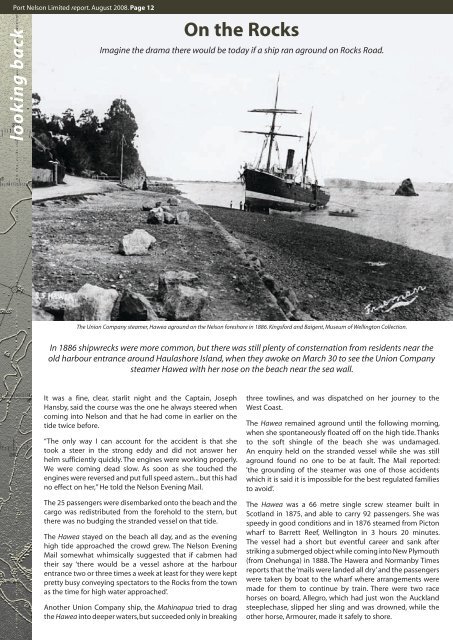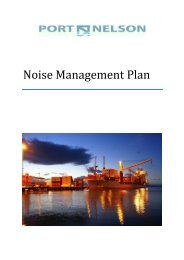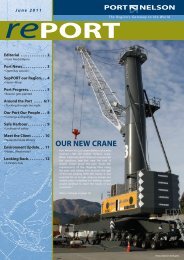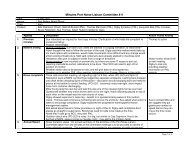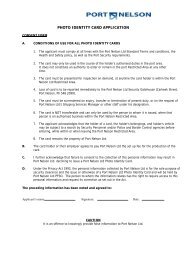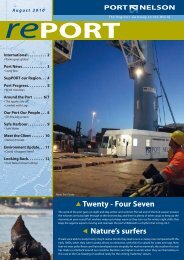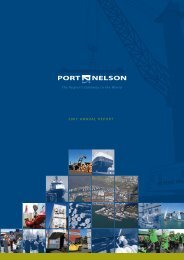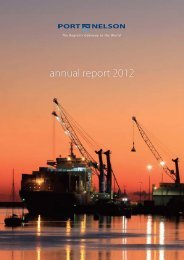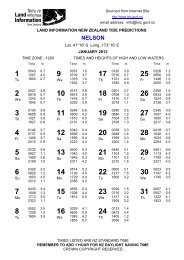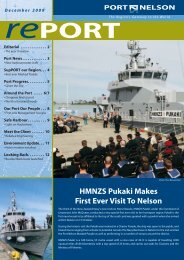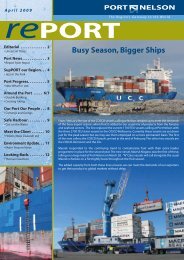August 2008(pdf) - Port Nelson
August 2008(pdf) - Port Nelson
August 2008(pdf) - Port Nelson
You also want an ePaper? Increase the reach of your titles
YUMPU automatically turns print PDFs into web optimized ePapers that Google loves.
<strong>Port</strong> <strong>Nelson</strong> Limited report. <strong>August</strong> <strong>2008</strong>. Page 12<br />
looking back<br />
On the Rocks<br />
Imagine the drama there would be today if a ship ran aground on Rocks Road.<br />
The Union Company steamer, Hawea aground on the <strong>Nelson</strong> foreshore in 1886. Kingsford and Baigent, Museum of Wellington Collection.<br />
In 1886 shipwrecks were more common, but there was still plenty of consternation from residents near the<br />
old harbour entrance around Haulashore Island, when they awoke on March 30 to see the Union Company<br />
steamer Hawea with her nose on the beach near the sea wall.<br />
It was a fine, clear, starlit night and the Captain, Joseph<br />
Hansby, said the course was the one he always steered when<br />
coming into <strong>Nelson</strong> and that he had come in earlier on the<br />
tide twice before.<br />
“The only way I can account for the accident is that she<br />
took a steer in the strong eddy and did not answer her<br />
helm sufficiently quickly. The engines were working properly.<br />
We were coming dead slow. As soon as she touched the<br />
engines were reversed and put full speed astern... but this had<br />
no effect on her,” He told the <strong>Nelson</strong> Evening Mail.<br />
The 25 passengers were disembarked onto the beach and the<br />
cargo was redistributed from the forehold to the stern, but<br />
there was no budging the stranded vessel on that tide.<br />
The Hawea stayed on the beach all day, and as the evening<br />
high tide approached the crowd grew. The <strong>Nelson</strong> Evening<br />
Mail somewhat whimsically suggested that if cabmen had<br />
their say ‘there would be a vessel ashore at the harbour<br />
entrance two or three times a week at least for they were kept<br />
pretty busy conveying spectators to the Rocks from the town<br />
as the time for high water approached’.<br />
Another Union Company ship, the Mahinapua tried to drag<br />
the Hawea into deeper waters, but succeeded only in breaking<br />
three towlines, and was dispatched on her journey to the<br />
West Coast.<br />
The Hawea remained aground until the following morning,<br />
when she spontaneously floated off on the high tide. Thanks<br />
to the soft shingle of the beach she was undamaged.<br />
An enquiry held on the stranded vessel while she was still<br />
aground found no one to be at fault. The Mail reported:<br />
'the grounding of the steamer was one of those accidents<br />
which it is said it is impossible for the best regulated families<br />
to avoid’.<br />
The Hawea was a 66 metre single screw steamer built in<br />
Scotland in 1875, and able to carry 92 passengers. She was<br />
speedy in good conditions and in 1876 steamed from Picton<br />
wharf to Barrett Reef, Wellington in 3 hours 20 minutes.<br />
The vessel had a short but eventful career and sank after<br />
striking a submerged object while coming into New Plymouth<br />
(from Onehunga) in 1888. The Hawera and Normanby Times<br />
reports that the ‘mails were landed all dry’ and the passengers<br />
were taken by boat to the wharf where arrangements were<br />
made for them to continue by train. There were two race<br />
horses on board, Allegro, which had just won the Auckland<br />
steeplechase, slipped her sling and was drowned, while the<br />
other horse, Armourer, made it safely to shore.


